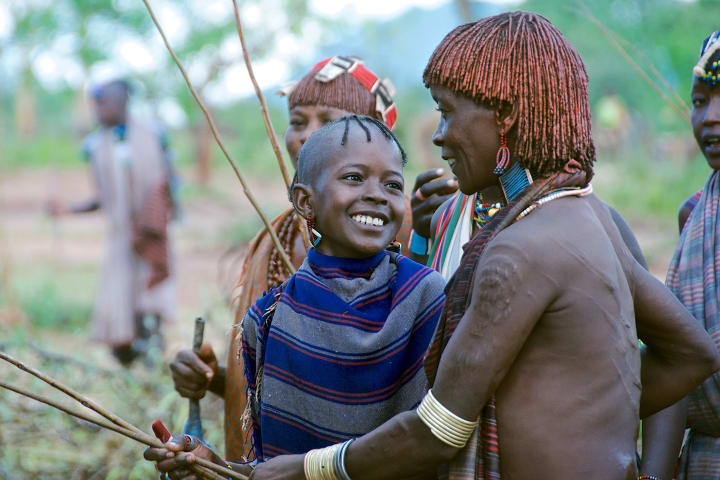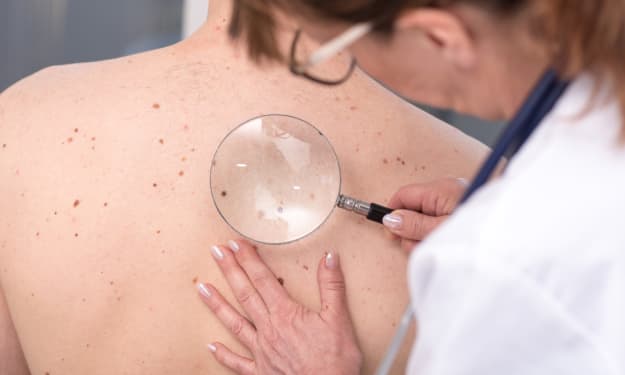Top 10 Amazing Beauty Treatments From Africa
Celebrate Black History!

Africans seem to have an unconventional idea of beauty. The continent is home to some of the most interesting beauty traditions ever. There is an actual male beauty contest held by the Wodaabe tribe in Niger. In Ethiopia, lip plates are popular body modifications among Mursi tribal women.
African beauty regimes can be just as fascinating. African tribes have developed natural skin and hair care regimes for centuries. The treatments from these regimes have proven to be beneficial. In fact, there is no wonder why most Africans are beautiful people. Here, I explore some of the most rejuvenating, moisturizing, beautifying treatments from Africa.

1. Chebe Powder
The Basara Arab women from the country of Chad have thick, long hair that usually grows past their waist. The women contribute their hair growth to a homemade mixture called chebe powder. The powder is said to be herbal and prevents hair damage. When applied to the hair, the powder along with water and oil provides moisture. This process makes the hair more manageable and ready for styling. The hair is then combed and re-braided into an individual plait. The women repeat this regime every five days.
One may believe the hair growth of these women is due to genetics. The women debunked this theory by stating they do not apply the powder to their bangs (which remain short).
2.The Buttered Hairstyles of The Afar Tribe
The women from the Afar tribe of Ethiopia usually braid their hair in neat, straight, designs. Married Afar women wear head scarfs over their braids but, singles do not. The men in the tribe are known for their buttery hairdos. Two traditional styles commonly worn by these men are called dayta and gunfura. The dayta is a curly hairstyle created when the hair is buttered and wrapped around a small stick to form a curl. The gunfura is a damp, buttered afro style. The butter used in these styles helps moisturize and protect the hair from the sun's harsh heat.
3. The Red Glow of the Himba Women
In Northwest Namibia, there is a tribe called the Himba people. Himba women have an interesting beauty regime that leaves their hair and skin red. The red skin glow of the Himba women is a result of a paste mixture called otjize. The paste is made of butter, fat and red ocher. Otjize is also used on a himba woman’s hair to create a style that forms into red, smooth, pasty locks. The women say they use the paste to beautify themselves because it acts as a form of makeup. The Himba women apply the paste every morning.
A popular belief is that otjize was used for sun protection and as an insect repellent. Also, some suggest the red color holds a symbolic meaning. Evidence shows that red ocher was used by different cultures for various reasons. Some used it to represent motherhood or menstruation. For whatever the use, the paste gives off a beautiful red hue.

4. The Red Locks of the Hamar Women
The Hamar or Hamer is a tribal community living in the Southwest region of Ethiopia. The women from the tribe are stunning dark beauties. Gorgeous Hamar women stand out by wearing colorful beaded jewelry and goatskin clothing. The Hamar women add the color red into their beauty regimes too. Perhaps, the most radiant feature on a Hamar woman is her hair.
The women are known for their signature small, short and shiny red locks. To create this hairdo, the hair is cut and shaped first. The women then use clay and fat to mat the hair when forming their locks.

5. Rooibos Tea
The Khoisan people of South Africa have been using an old herbal tea remedy. The tea contains several antioxidants, zinc, and calcium. The secret to this beneficial tea is the rooibos plant. The plant only grows in the Suid Bokkeveld region of South Africa. Rooibos plants can treat many skin disorders such as acne, eczema, and dermatitis. The smooth complexions of the KhoiSan people are maybe due to the tea's skin benefits.
Also, rooibos tea can improve heart health and balance cholesterol levels. A study was done in 2011 on 40 people at risk for cardiovascular disease who drank the tea. All the participants of the study had improved cholesterol levels afterward. The tea can help manage your weight too. Rooibos tea is a zero-calorie beverage which, makes it great for weight loss. Would you like to brew rooibos tea? If that's a yes, then great! Try mixing the tea with other healthy ingredients. Rooibos and honey would work well together. Adding honey to your rooibos tea will give it an extra benefit. Honey is rich in antioxidants that are great for the body too.
6. Moroccan Rhassoul Clay
Rhassoul clay is a brown type of clay found in the Atlas Mountains in Morocco. The clay received its name from the Arabic word Rhassalah which means washing. Many cultures have used this clay for an aesthetic purpose, but it has healing properties too. Calcium, potassium, and magnesium are some of the beneficial elements that are in the clay. The clay is an excellent skin cleanser because it clears up acne and impurities.
Besides, this clay being great for the skin, it is also great for hair. When used as a deep conditioner, rhassoul clay can restore shine and strength to the hair. Moroccan women use the paste to reduce oil and to add volume to their hair. Also, you can experience the fresh feeling of a clean scalp by using the clay as a hair mask. Just take some rhassoul clay powder and add some water to it to make a smooth paste. Then, spread it all over the hair! Leave it on your hair for about 20 to 40 minutes. After rinsing, your hair should feel refreshed.

7. The Dukhan
Sudanese women have a traditional beauty practice that slightly tans and detoxifies their skin. The practice is called dukhan, an Arabic word that means smoke. Dukhan is usually performed by married Sudanese women who practice this beauty ritual regularly. Dukhan is also a healing treatment. The ritual is believed to cure body ailments like arthritis.
The ritual involves stoking, burning charcoals until they glow. The coals are then put into a pot along with wood and acacia. The bride then covers her nude body over the pot with a sheet or blanket. The sweet smoke aura gives the body a pleasant scent and softens the skin. The scent usually lasts for days.
8. Somali Qasil Mask
Somalian women are some of the most beautiful women in the world. The flawless and ageless skin of these women is amazing! Most Somalian women make a facial mask which may be the secret to their smooth skin. The main ingredient to this facial mask is qasil. Qasil is a green cleansing powder made from leaves that belong to the Gob tree. Qasil powder has been used to exfoliate, soften and clear the skin.
The qasil mask is homemade with other beneficial ingredients such as turmeric and safflower. Somalian women mix water with the powder and ingredients before applying it to the skin. Also, qasil can be used as a natural shampoo for hair. Qasil removes build up, and dirt from the scalp and improves the hair’s condition.
9. African Black Soap
Originating from West Africa, black soap or African black soap is a rejuvenating skincare product. The soap is homemade from the ashes of plants such as cocoa pods or palm tree leaves. The ashes are blended with water, shea butter, palm oil, and coconut oil. This mixture gives the soap a shiny dark color. The ingredients help prevent fine lines, even the skin tone, and remove blemishes.
Also, black soap is an antibacterial cleanser. The soap has even been proven to work better than most chemical cleaners. The soap is light, gentle, and good for all skin types too. If you are worried about black soap, making your skin oily, think again. The shea butter in the soap adds moisture, and coconut oil prevents excessive amounts of oil. After using the soap, your skin is oil-free. For thousands of years, West Africans have made and used black soap to maintain their flawless skin. Particularly, Ghanaian women continue to this day to use and make the soap.
10. African Shea Butter
Perhaps, shea butter is Africa's most well-known beauty treatment. The butter comes from the shea tree that grows in the West and central regions of Africa. The shea nuts from the tree contain moisturizing oil which is beneficial to the skin and hair. Shea butter can act as a healing agent for eczema and cures dry brittle hair. Several hygienic products such as soap and shampoo were made from shea butter for ages in Africa. Shea butter was even used for cooking food. Anthropologist Daphne Gallagher studies have possibly found the origins of processing Shea nuts. Gallagher's team says since A.D 100 Africans have processed the nuts.
Particularly, Gandhian women have an interesting way of processing shea butter. The women roast the Shea nuts before crushing and grinding them into a soft powder. Then, the women turn the Shea powder into a smooth consistency. The shea paste is boiled in a hot pot until the oils come up and settle. Once the process is finished, natural shea butter is white but, it can be a yellow color too.If you would like to make body butter with shea butter as an ingredient, browse the web. There are several online recipes and books on shea butter that will help.
Conclusion
Thank you for reading! Make sure you follow me on Instagram @zarilove9619. Also, subscribe to my YouTube.
About the Creator
Zari's Diary
Hey everyone! I'm Zari welcome to my diary! I started this blog to express and discuss my passion for writing, crochet, art, singing, dance, and poetry! Yes! I'm very talented! Follow me as I create!






Comments
There are no comments for this story
Be the first to respond and start the conversation.